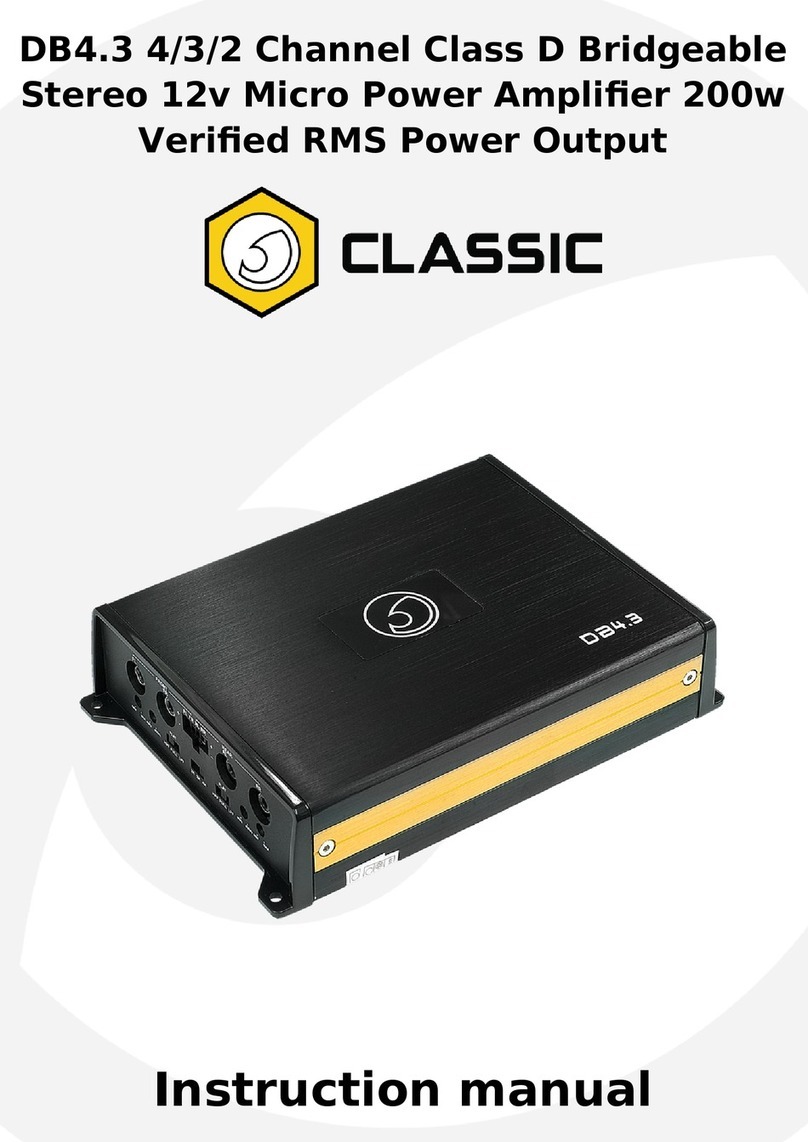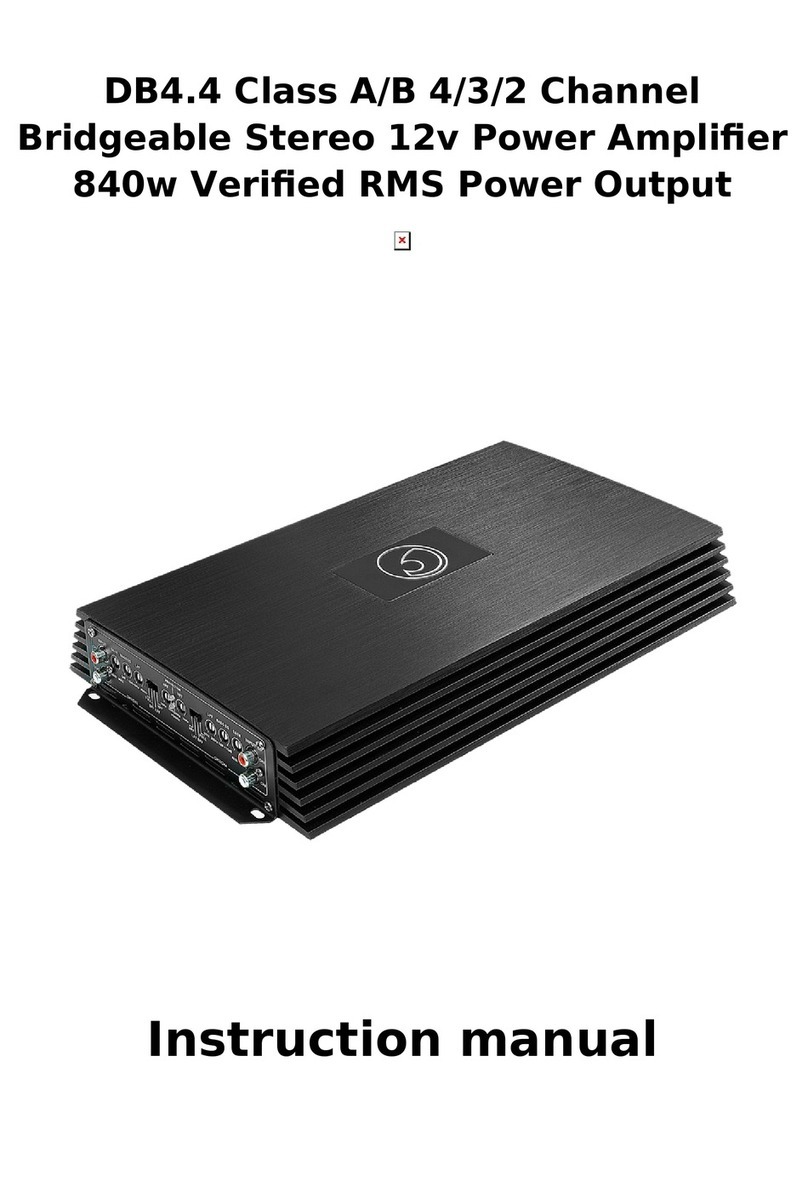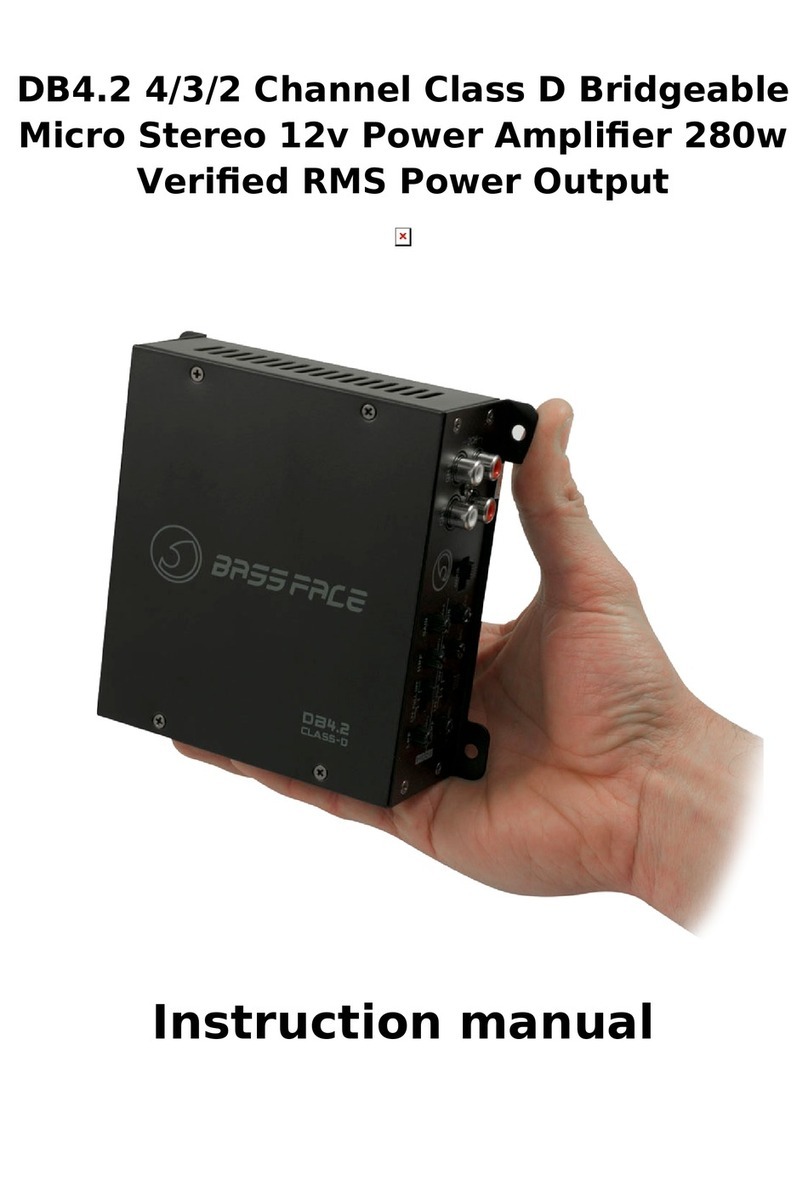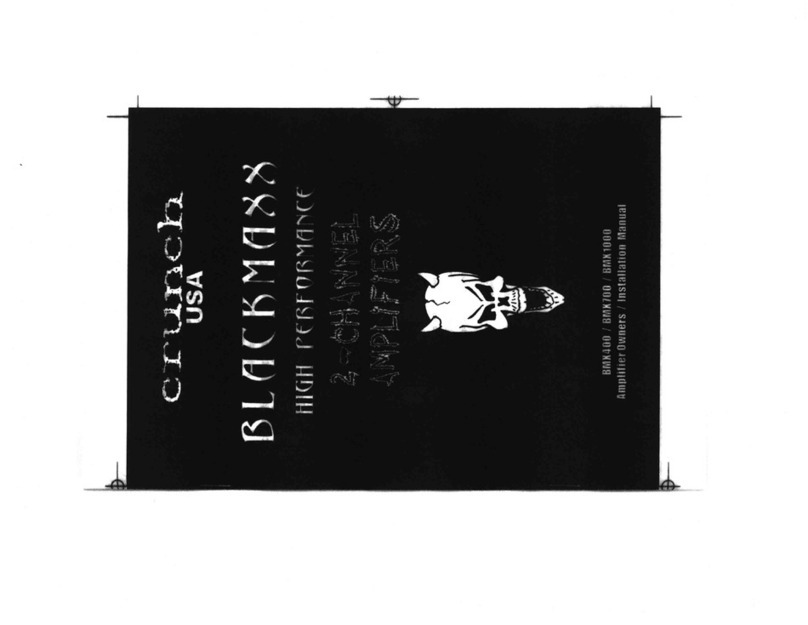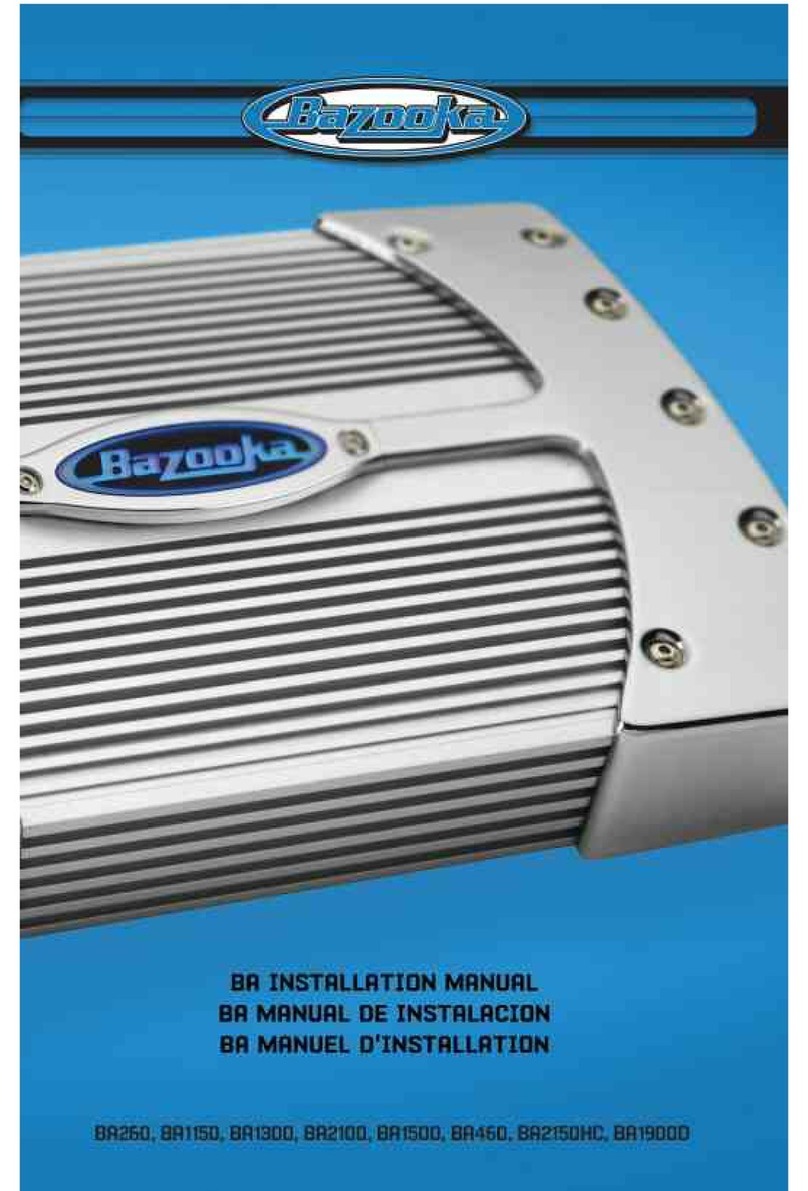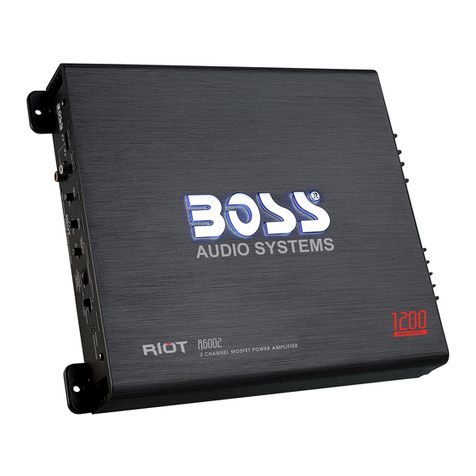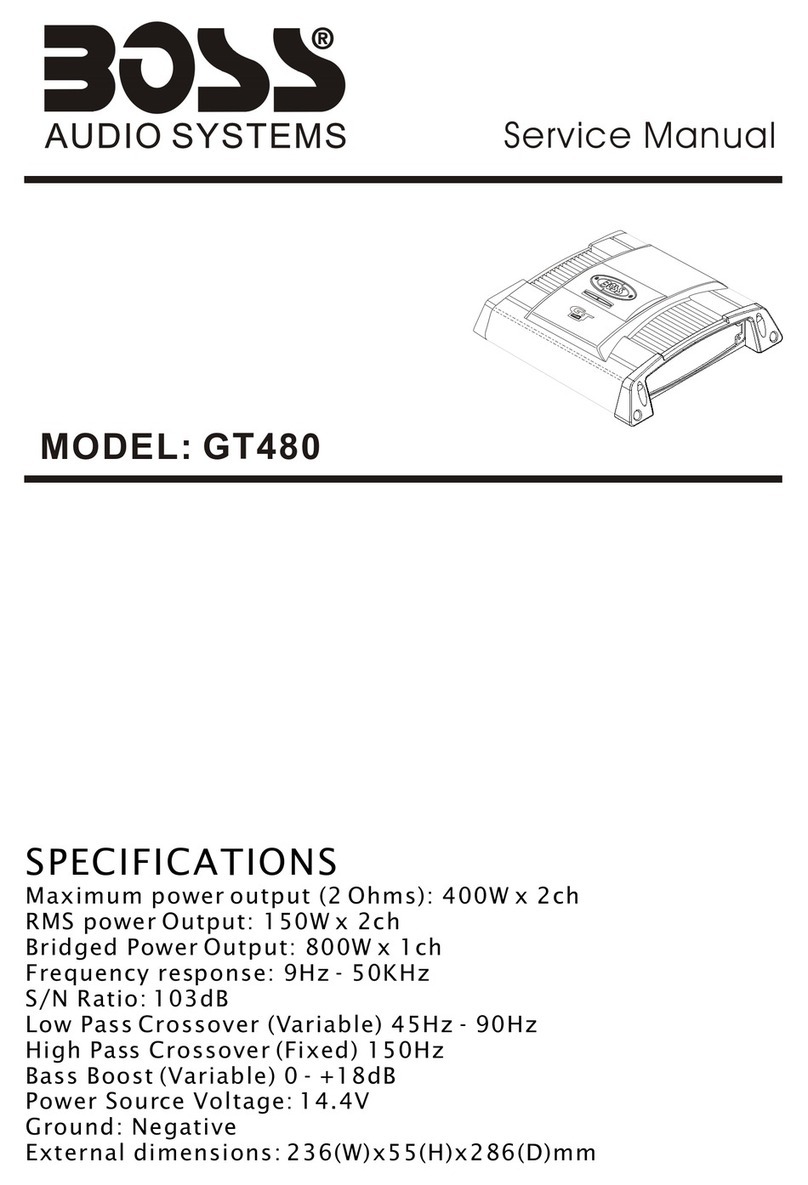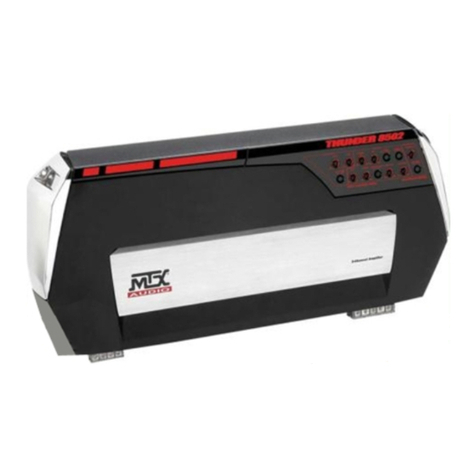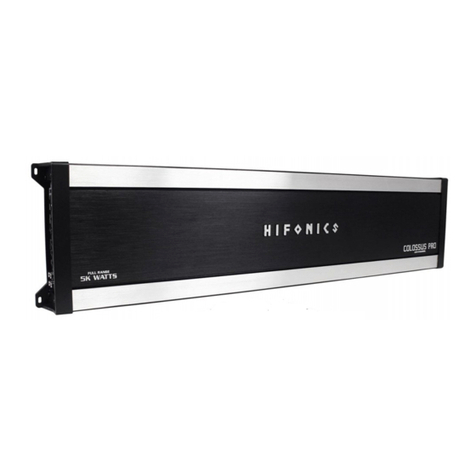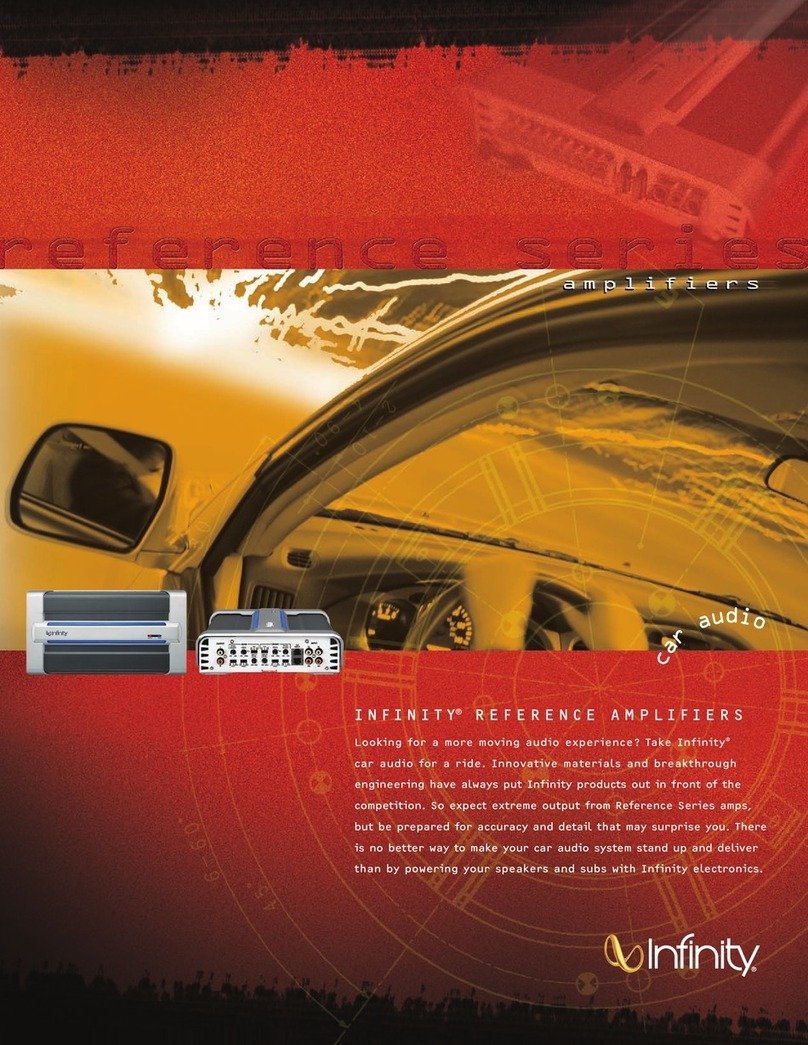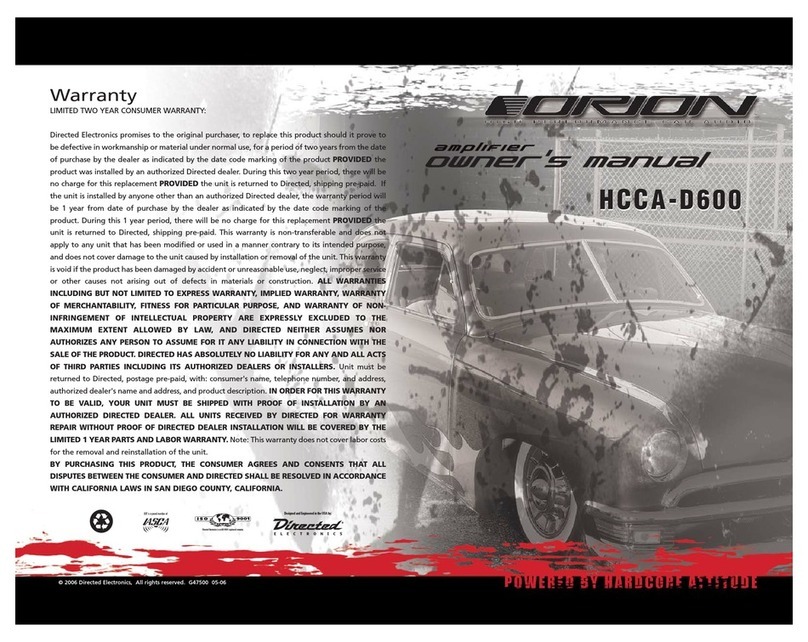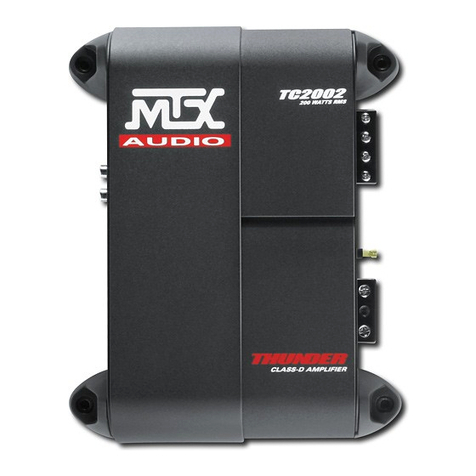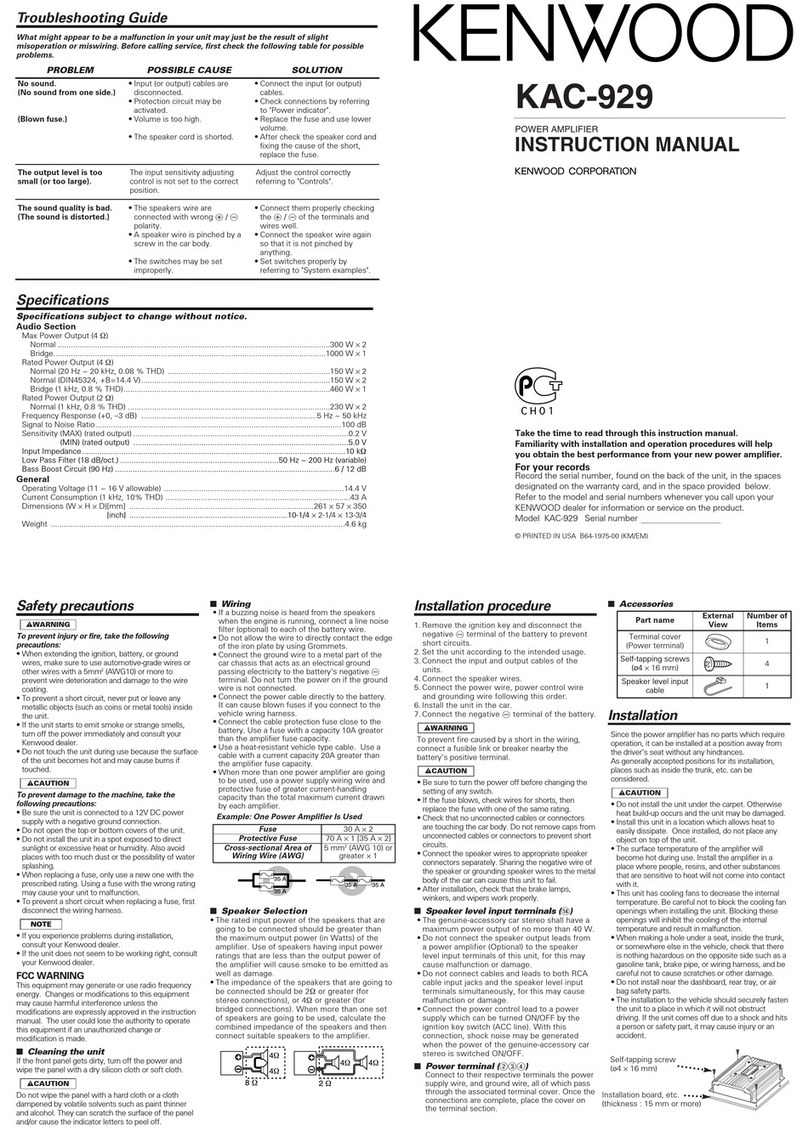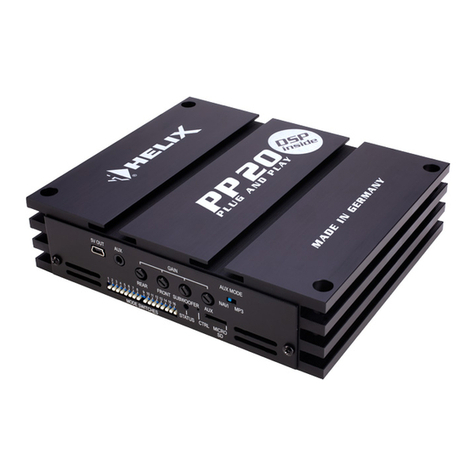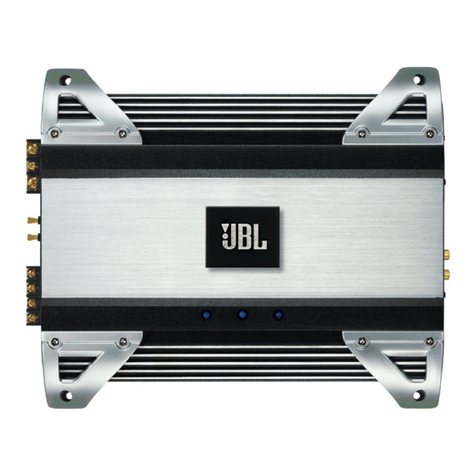BASSFACE Hammer DB1.8 User manual

DB1.8 1Ohm Class D Monoblock
Subwoofer 12v Power Amplifier 7200w
Verified RMS Power Output
Instruction manual

Thank you for choosing Bassface. From the simplest connector to our top of the range
amplifier - every element of these products has been designed to give you the best possible
performance for your money. Please take the time to read these instructions carefully as
they contain useful and important information. Modern high power audio systems can
generate voltages at the speaker similar to mains operated equipment – for some reason
everyone seems to ignore or forget this. Your wiring needs to be good to be safe. Please
remember this and take your time. Please exercise caution when setting volume levels –
powerful audio equipment can easily produce enough sound to permanently damage
hearing. Remember that audio competitors use ear protection when operating and
competing. Do remember that incorrect installation or abuse is not covered under warranty
– please make sure that your installation and any partnered product is suitable and
compatible. If you are unsure please seek qualified advice before proceeding. Always use
appropriate hand and eye protection when working with tools, and always work within your
capabilties as an installer. We offer a 12 month manufacturer warranty via your distributor
or retailer. Please retain your purchase receipt as proof of purchase. Please note that
Bassface operates a policy of continuous product development and we reserve the right to
change specification without prior notice. You can follow our process on our website by
reviewing the version history information.
Please note that we sometimes include information inside these manuals which we feel is of
potential value to the client on related subjects such as conversion charts, capacitance
values or wiring diagrams. Please feel free to copy any of this information since it is in the
public domain.


To begin, disconnect the car battery, taking note of any required precautions suggested by
the vehicle manufacturer such as alarm or radio codes, or on board computer or AGM
battery requirements.
For vehicles with front mounted batteries find a suitable point on the firewall/bulkhead to
run the power wire through. Where the cable passes through the metal it is absolutely vital
that a rubber grommet be fitted to prevent the cable from chafing through the insulation as
this would be a major fire risk. The positive wire needs to go to the + positive terminal on
the battery. A fuse of appropriate size to protect the cable needs to be fitted in line no more
than 18” from the battery.
Once you have the power cable in the car, run it back to the boot or to where you intend to
fit the amplifier. When you do this, be aware that you will need to run the remote turn on
cable and the RCA signal cable from the head unit back to the amp too.
If the wires you are running have to run over or go alongside other looms of the car, try to
cross them at right angles to avoid unwanted interference in the signal, and try not to run
them parallel with other cables either. If you can, run the power and the signal cables down
opposite sides of the car. This isn’t essential but if you do get any interference once the job
is complete the first thing to look at will be separating these wires so if you can do it first it
makes a lot of sense!
The absolutely most important aspect of the power install is the earth wire. This wants to
be very securely bolted to the chassis of the car. We recommend drilling a hole (take care
not to drill through your spare tyre, brake lines or anything else) in the boot floor and sand
off any paint to the bare metal where the wire will be connected. A bad earth is a very
common flaw in installation and can cause a number of headaches later down the line so be
sure to take care in doing this. Do not use a self tapping screw to secure the earth down, as
it will probably soon come loose and impair performance. Other common disasters include
trying to earth to rear light mounting bolts, boot lock mountings and other ways to “trap”
the cable in the hope you might get a good earth. For every volt the amplifier doesn’t see it
requires twice the power to create the same output which means poor performance and a
possible broken amplifier. Once the work is complete neatly repaint the over the finished
bolted connector and chassis of the car with some primer to prevent corrosion.
We would like to make clear that the current demands of modern high power car audio are
highly significant, and dependant upon the speaker loads, gain levels and supply voltage.
We make every reasonable attempt to publish test results showing the likely current
consumption of each of our amplifiers, and we urge installers - even ones engaged in
modest car installations - to make provision for these current demands. Poor power supply
planning and a failure to provide sufficent energy to run the amplifiers is amongst the
number one reason for premature (or instant!) failure of the unit. It can also destroy
speakers, source units and even cause fire.
On a related matter, we have been made aware of the use of Bassface products in
situations where bench power supplies (or power supplies that are not a conventional car
battery/alternator) are used to power our products. From a purely technical standpoint
there is no good reason why this cannot be accomplished successfully BUT it is absolutely
critical that current provision is made with reference to the appropriate test estimates. We
need to make clear that due to the number of possible technical hurdles we are unable to
extend warranty to any kind of installation where the power source is not a 12v

car/alternator combination that meets necessary requirements.
It is also very important that a power amplifier is not used without an appropriate speaker
load on each channel. The design of each amplifier is different, and so some amplifiers will
tolerate running with open circuit channels, wheras some absolutely will not. It is easy to
quickly damage an amplifier if channels are left open. Always make sure minimum
impedance requirements are met. The most common examples we see are four channel
units where one half of the amp is used to run a pair of speakers or a subwoofer (even
worse) and the other side is left undriven. This will almost certainly destroy components on
circuit board resulting in smoke/fire/certain failure of the amplifier. We have also seen
similar incidents where mono amps have their load removed (subwoofer taken out of the
boot on a quick release) but where the remote cable still powered up meaning the amp is
receiving a full signal! This is also likely to fill your car with expensive smoke. It goes
without saying, but we will say it anyway, that this is yet another warranty void situation.
(And like all the other ones, it is easily avoidable!)

The first step when installing an amplifier is to lubricate the terminals. The reason for this is

that sometimes, the plating applied to the screws can rub off slightly in the threads,
causing binding. This can then result in damaged threads and/or rounded screw heads. We
recommend the use of a medium thickness general purpose oil. In the UK there is a product
known as "3 in 1" oil which we like to use in the workshop, but any reasonably thick,
decently penetrating oil will work. We do not recommend the use of spray lubricants for this
job because they are too thin, wont penetrate the threads and can contaminate the
cosmetic surface of the product. Also, whilst it might sound like a simple and obvious thing
to say, please make sure that you use the correct allen key or screwdriver when operating
the amp terminals. The screws are made from relatively soft material, and can very easily
become rounded and damaged over time. We see this ALL the time in our repair centre, so
we KNOW that some of you don't read these manuals! Thanks for being one of the careful
ones.
Location and Cooling
Locate the amplifier unit in a perfectly dry part of the vehicle. Ensure this location takes
account of temperature and offers sufficient air exchange to keep the unit cool. Depending
on how hard you will be running the unit it might be necessary to employ additional
external cooling. Do not allow the unit to be "hot boxed" or to overheat even at peak load
periods because it is not good for the components to bake in their own extra heat. We
recommend using temperature probes during the initial setup to monitor the core
temperature. We like to try to hold the core temperature to no more than 50 degrees
Celsius as this ensures optimum performance. Baked DB1.8’s are NOT covered under
warranty.

Physical Mounting
When physically securing the unit to the vehicle you MUST ensure that the chassis of the
amplifier is isolated from vibration. The DB1.8 uses a sliding PCB design, which means that
the circuit board of the amplifier is held in place by the heat sink. This offers great stability
for such an enormous board but it means that all the vibration caused by your subwoofer
system will be transferred directly into the fragile PCB if you just bolt the amp to the floor of
the car. We recommend the use of some simple soft rubber feet, at least an inch tall, to
create a safe installation. Under NO circumstances can the DB1.8 be mounted directly to
the woofer enclosure! Cracked circuit boards are NOT covered under warranty.

Wiring Notes - Earth
As you’d expect the DB1.8 uses some serious power. You need to use 2x4AWG inputs for
the power and 2x4AWG inputs for the earth. Keep the earth short (aim for <12 inch), and
use separate bolts (NOT self tappers!) down to the bare metal of the chassis for the
connections. Tie these off with a decent strain relief and paint over the finished install to
protect the metal and preserve the integrity of the electrical joint. Always meter off the
finished earth job prior to hookup and do not accept anything worse than 0.05 ohms of
resistance in the cables to the floor. You’re aiming for zero really at this level. Also please
take time to check: Car battery to chassis earth. Alternator to chassis earth. Any additional
engine to chassis earth straps. These things are also important when you are about to suck
200A out of the system. The power chain is as strong as the weakest link! Blown circuit
boards caused by resistance in the earth path are NOT covered under warranty.

Wiring Notes – Power
Ensure you have enough power at the distribution point to drive a pair of 4AWG feeds into
the board. This will mean something like a 0AWG from the car battery, capacitor bank or
supplementary battery. Don’t overlook the increase in resistance over long cable runs.
Installing a zero gauge power feed along the length of a vehicle is a considerable task –
running a second cable at the same time nowhere near twice the work but this can be a
very worthwhile exercise and brings enormous benefits in terms of power transmission and
stable voltage levels. Blown circuit boards caused by low voltage at the input terminals are
NOT covered under warranty.

Wiring Notes – General
Safety is crucial during these installations. Firstly, please ensure that you protect every
current carrying cable with an appropriate fuse. Remember that if you use a capacitor or
supplementary battery you have the potential to be back feeding the main cable up the car
FROM the back so you will need to use a fuse a short distance from these storage devices
as WELL as a fuse at the front of the vehicle near the battery. Make absolutely certain that
the insulation of the cable is not pressed up against sharp edges or anything that could
gradually cut its way through. Always use cable grommets where wires pass through metal
or other perpendicular surfaces. Finally, ensure that your wiring is protected from coming
loose by using strain relief points on the cable. Please do not for one second dismiss the
possibility of a badly installed amplifier causing a fire. Do it properly. Barbecued cars and
owners are NOT covered under warranty ;-)

Signal and Speaker Connections
Signal input is by means of a pair of RCA connectors at the speaker output end of the amp.
There is also a helpful pair of RCA outputs, which mirror the inputs, to assist with onward
signal requirements.
Fit the remote control knob and route the cable to a convenient place.
The speaker outputs are mono, obviously, so you can use either or both of each polarity to
drive each woofer as required, or for bi-wiring in the case of a (big!) single coil single
woofer. The unit is rated to 1 ohm stable. Destroyed DB1.8’s that have been abused in
competition to extract the absolute maximum power possible from the unit by running at
less than 1 ohm of load are NOT covered under warranty. If you need more power, buy
more amplifiers. Don’t wreck the one you have and expect someone else to pay for it!

Daisy Chain
If you are using 2xDB1.8 in a daisy chain configuration you must switch the master/slave
control on each to choose which unit will be in control. Connect the two together using an
appropriate 4 pin RJ45 style cable. Plug into the Master Output terminal FROM the master
and Slave Input terminal TO the Slave. Please make this change BEFORE powering the units
up. Failure to get this correct before power up for strapped operations can result in damage
to the processor which is NOT covered under warranty.
Setup
Once everything is perfect and you’re ready to go set the gain to minimum and put the
fuses in and apply power to the remote terminal. We recommend also setting the gain on
the remote to zero as this control is a gain control with 18db of range.
Begin with the bass boost at 0db, the phase shift at 0 degrees and the subsonic set to a
suitable value to save power below the real output floor of your woofer. Dial in the low pass
filter (all these are 12db/octave) and ensure your source unit or processor is also
appropriately set to zeroed.
We recommend a conservative gain structure, leaving headroom in the remote control to
allow real world tweaking of the level to suit the recording from the cockpit. We don’t
recommend that you gain the amp up to the maximum level for the most dense music you

have because then the remote will result in over gain, dynamic compression and toasted
woofers! (And I’m sure THAT isn’t covered under warranty by your woofer manufacturer,
either!)
Finally – the bass boost control is a parametric design which takes its centre frequency from
the Bass Freq knob and applies gain as per the Bass Boost setting with a fairly wide Q. I
recommend that you decide if you will need to use this from the outset, depending on the
profile of your woofer system, and then you can build in gain headroom to accommodate
the boost. (Otherwise you’re into dynamic compression again).
Finally
The DB1.8 is a competition monster – we thank you very much for your purchase and feel
certain that the product will blow you away. If you have any questions about setup or use
please feel free to contact us and we will be pleased to assist.
Other BASSFACE Car Amplifier manuals
